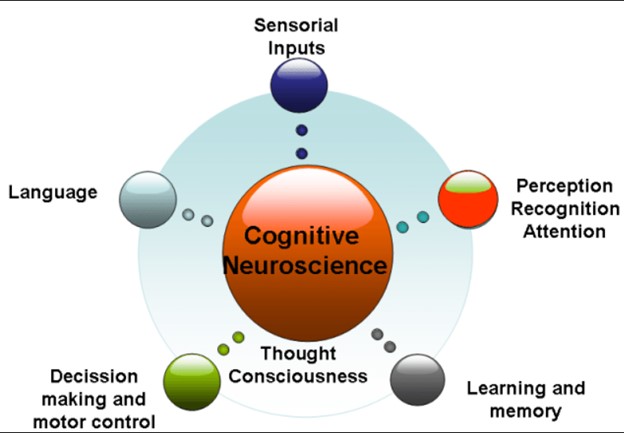Cognitive Psychology and Cognitive Neuroscience

Cognitive Psychology and Cognitive Neuroscience – Imagine the following situation: A young man, let’s call him Knut, is sitting at his desk reading some papers which he needs to complete a psychology assignment.
In his right hand he holds a cup of coffee. With his left one he reaches for a bag of sweets without removing the focus of his eyes from the paper. Suddenly he stares up to the ceiling of his room and asks himself: “What is happening here?”
Probably everybody has had experiences like the one described above. Even though at first sight there is nothing exciting happening in this everyday situation, a lot of what is going on here is highly interesting particularly for researchers and students in the field of Cognitive Psychology.
They are involved in the study of lots of incredibly fascinating processes which we are not aware of in this situation. Roughly speaking, an analysis of Knut’s situation by Cognitive Psychologists would look like this:
Knut has a problem, he really needs to do his assignment. To solve this problem, he has to perform loads of cognition. The light reaching his eyes is transduced into electrical signals traveling through several stations to his visual cortex.
Meanwhile, complex nets of neurons filter the information flow and compute contrast, color, patterns, positions in space, motion of the objects in Knut’s environment.
Stains and lines on the screen become words; words get meaning, the meaning is put into context, analyzed on its relevance for Knut’s problem and finally maybe stored in some part of his memory.
At the same time an appetite for sweets is creeping from Knut’s hypothalamus1, a region in the brain responsible for controlling the needs of an organism. This appetite finally causes Knut to reach out for his sweets.
Now, let us take a look into the past to see how Cognitive Psychologists developed its terminology and methods to interpret ourselves on the basis of brain, behavior and theory.
Early thoughts claimed that knowledge was stored in the brain.
Renaissance philosophers of the 17th century generally agreed with Nativists and even tried to show the structure and functions of the brain graphically. But also, empiricist philosophers had very important ideas.
According to David Hume2 , the internal representations of knowledge are formed obeying particular rules. These creations and transformations take effort and time.
Actually, this is the basis of much current research in Cognitive Psychology. In the 19th Century Wilhelm Wundt3 and Franciscus Cornelis Donders4 made the corresponding experiments measuring the reaction time required for a response, of which further interpretation gave rise to Cognitive Psychology 55 years later.
During the first half of the 20th Century, a radical turn in the investigation of cognition took place. Behaviorists like Burrhus Frederic Skinner5 claimed that such mental internal operations – such as attention, memory, thinking – are only hypothetical constructs that cannot be observed or proven.
Therefore, Behaviorists asserted, mental constructs are not as important and relevant as the study and experimental analysis of behavior (directly observable data) in response to some stimulus.
According to Watson and Skinner, man could be objectively studied only in this way. The popularity of Behavioralist theory in the psychological world led investigation of mental events and processes to be abandoned for about 50 years.
In the 1950s scientific interest returned again to attention, memory, images, language processing, thinking and consciousness. The “failure” of Behaviorism heralded a new period in the investigation of cognition, called Cognitive Revolution6.
This was characterized by a revival of already existing theories and the rise of new ideas such as various communication theories. These theories emerged mainly from the previously created information theory, giving rise to experiments in signal detection and attention in order to form a theoretical and practical understanding of communication.
Modern linguists suggested new theories on language and grammar structure, which were correlated with cognitive processes. Chomsky’s7 Generative Grammar and Universal Grammar theory, proposed language hierarchy, and his critique of Skinner’s “Verbal Behavior” are all milestones in the history of Cognitive Science.
Theories of memory and models of its organization gave rise to models of other cognitive processes. Computer science, especially artificial intelligence, re-examined basic theories of problem solving and the processing and storage of memory, language processing and acquisition.
Neuroinformatics8, which is based on the natural structure of the human nervous system, tries to build neuronal structures by the idea of artificial neurons. In addition to that,
Neuroinformatic is used as a field of evidence for psychological models, for example models for memory.
The artificial neuron network “learns” words and behaves like “real” neurons in the brain. If the results of the artificial neuron network are quite similar to the results of real memory experiments, it would support the model.
Read Much More Inside…
Download Your Copy Now $27

Click on the Red Button Below for Instant Access!
Your name and email will Never be shared, sold, or given to anyone.
Regards, Coyalita
Behavioral Health Rehabilitative Specialist & Drug and Alcohol Addiction Counselor
Copyright © 2021- 2023 FitnessHealthcoyalita.com All Rights Reserved – Earnings Disclaimer – Terms of Use – Contact Us
